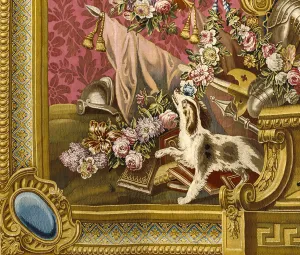Charles Coypel
The Enduring Success of Charles Coypel’s
Story of Don Quixote
I’ll wager that before long there won’t be a tavern, an inn, a hostelry, or a barbershop where the history of our deeds isn’t painted.
—Miguel de Cervantes, Don Quixote
Uttered by Sancho Panza, these boastful words would prove prophetic. Charles Coypel’s paintings gained wide exposure and additional fame from a series of twenty-five black-and-white engravings made between 1723 and 1734 under his personal direction (fourteen of which were on view). The first twenty-two prints were published in large format, and as reverse images of his cartoons, by his lifelong friend and collaborator Louis Surugue père. By the 1730s, three more plates were added, reproducing the latest scenes painted by Coypel. In addition to Surugue, the engravings were entrusted to some of the most distinguished French eighteenth-century printmakers: Charles-Nicolas Cochin père, François Joullain, and Bernard Lépicié. These printmakers worked from preparatory drawings made by Coypel after his own paintings, which explains the inscription Coypel invenit, or designed by Coypel (and not Coypel pinxit, or painted by Coypel) at the lower left of each plate.
Accessible to only a few wealthy patrons, the tapestries remained luxury items throughout the centuries while the engravings were affordable for a larger public. Thousands of sheets were printed and sold individually or in folios. Reproduced and reduced in size, the prints also illustrated other editions of Cervantes’s novel, not only in French but in English and Dutch as well. In 1746, the engravings after Coypel even became a substitute for Cervantes’s words in the lavish book of the Dutch publisher Pieter de Hondt, who cut part of the novel to accommodate the large plates. Four of these early editions were on view. With this series of engravings, Coypel became the most influential eighteenth-century illustrator of Cervantes’s novel.
Throughout the eighteenth century, Coypel’s designs continued to influence tapestry production in France and abroad. Around 1730−45, the Brussels workshop of Peter van den Hecke produced a series of eight tapestries illustrating Don Quixote, with six of them inspired by engravings after Coypel, two of which belong to The Frick Collection and were on view for the first time in more than ten years. Visually different from the Gobelins Don Quixote tapestries, the scenes cover the entire surface of the tapestry panel and are surrounded by a simple border that simulates a carved and gilded frame. The designer of the cartoons, Philippe de Hondt, created the new compositions by adapting, or combining, elements from engravings after Coypel. Working within a Flemish tradition, de Hondt transposed Coypel’s figures to a village scene recalling pictures by David Teniers the Younger rather than setting his figures on an eighteenth-century French stage. Appreciated abroad, seven Van den Hecke panels, including the two Frick tapestries, were acquired by the French court in 1748, when the same court was sponsoring the production of the Gobelins Don Quixote tapestries. A year later, the Flemish tapestries were displayed at the Château de Compiègne in the study of Louis, Dauphin of France, son of Louis XV.
With these two Flemish tapestries, the exhibition brings Coypel’s designs full circle — from the original cartoons to the woven Gobelins tapestries to reproductions in prints and books and later tapestries from the workshop of Peter van den Hecke.
Gobelins Tapestry Manufactory, Sancho Arrives on the Island of Barataria (detail), 1772, The J. Paul Getty Museum, Los Angeles

